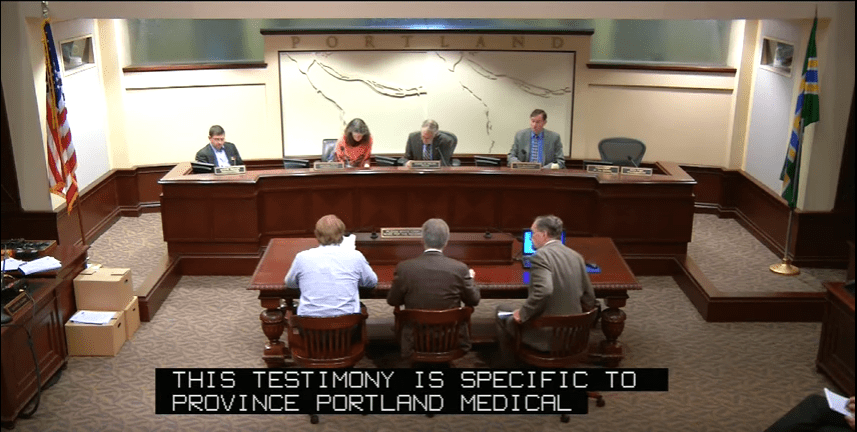
It is ironic that hospitals are sometimes the most vocal opponents against policies that encourage healthy transportation choices and improve community health. At the public hearing on October 13, Theron Park and Michael Robinson, representing Providence Portland Medical Center, expressed their opposition to the proposed new Transportation Demand Management (TDM) program (title 33.266.410 in the draft zone code amendments), citing that “the requirement of pay-to-park could affect and will affect the lowest wage caregivers” and “the lack of administrative rules” as reasons to not adopt this TDM requirement.
Their claims are at best unsupported by evidence, if not disingenuous. Rather than actually advocating for low-wage workers or being a good public steward for the City, Providence wants to see a good policy fail because it does not want to charge its employees for parking and encourage them to use healthier modes of transportation.
The “Poor” Excuse
Opponents of pricing parking often use concern for poor workers as their number one reason to keep parking free. As I have discussed in a previous article, there are many things that poor people need more than parking, such as housing, food, and health care, but somehow free parking gets a “free pass”.
Providence claims that “pay-to-park could affect and will affect our lowest wage caregivers”. But this concern can be easily be addressed by (1) surveying all employees at the Providence hospital to understand how workers actually get to work; and (2) offering parking discounts or commute subsidies to low-income workers who are car-dependent.
It is possible that Providence has no idea how their low-wage workers are getting to work because there is currently no TDM policy that requires medical institutions to track how their employees are getting to work. In addition, cities like Austin and Sacramento have adopted low-income employee parking permits to ease the financial burden of priced parking. The City of Portland has also adopted a similar program to accommodate low-wage workers when City Council raised downtown meter rates to $2 an hour.
So how many “lowest wage caregivers” are there at Providence? Using the Longitudinal Employer-Household Dynamics mapping tool, I estimate that approximately 7.5% or 350 of all Providence employees earn less than $15,000 a year. Since car-ownership is a huge financial burden, a it is probable that significant portion of Providence’s low-income worker use non-driving modes of transportation to get to work (the Hollywood Transit Center and 3 bus lines are within ¾ of a mile). So saying that you don’t want to charge for parking because it may burden the 7.5% of your employees who are already unlikely drive sounds a lot like a disingenuous excuse to continue to give free parking to wealthier employees.
Success in Seattle: Lesson for Portland
At the start of the public hearing, Mr. Park touted that Providence has already “reduced single-occupancy vehicle rate from 88% to 68% in the past two years”. To be fair, that is a pretty good reduction. However, compare to Seattle Children’s Hospital, Providence certainly has a lot of room for improvement. Seattle Children’s Hospital has a 38% drive-alone commute rate in 2006 and it has set an ambitious TDM target to reduce the share of drive-alone commuters to 30% by 2028.
The general rule for reducing driving is to make it more attractive to take alternative modes of transportation and less attractive to drive, and Seattle Children’s Hospital has a “multi-faceted strategy” to achieve just that.
The hospital offers a variety of incentives to not drive:
- free transit passes;
- free bicycles for employees who pledge to bike at least two days a week;
- Guaranteed Ride Home to those who carpool, walk, bike, or take transit – a free taxi ride home in the case of an emergency;
- $4 a day added to your paycheck for those who do not drive;
- free shuttle service from transit hubs to the hospital.
At the same time, the hospital’s parking policy creates disincentives for driving:
- charging for parking on a daily-basis;
- daily parking pricing ranges from $2.25 to $10;
- requires some employees to park off-site and take the shuttle to work.

Buying a monthly parking permit is an investment that encourages you to drive and park as much as you can since it is already paid through the month. A daily-pricing structure provides more flexibility to allow commuters to decide which mode they want to use each day.
Providence seems to be very concerned that City Council will adopt a TDM policy without knowing how to implement it. However, the example of Seattle Children’s Hospital shows that it is not very difficult to implement multiple TDM strategies at once and medical institutions can reap many benefits from offering a diverse set of commute benefits and having healthier and productive employees.
We have a rare opportunity on the table to adopt a TDM policy that will help meeting our transportation and climate goals and give people more mobility options and the choice to be healthy. Providence and other health-care institutions should get out of the free parking business and stop holding back Portland from adopting sustainable and healthy transportation practices.
Leave a Reply